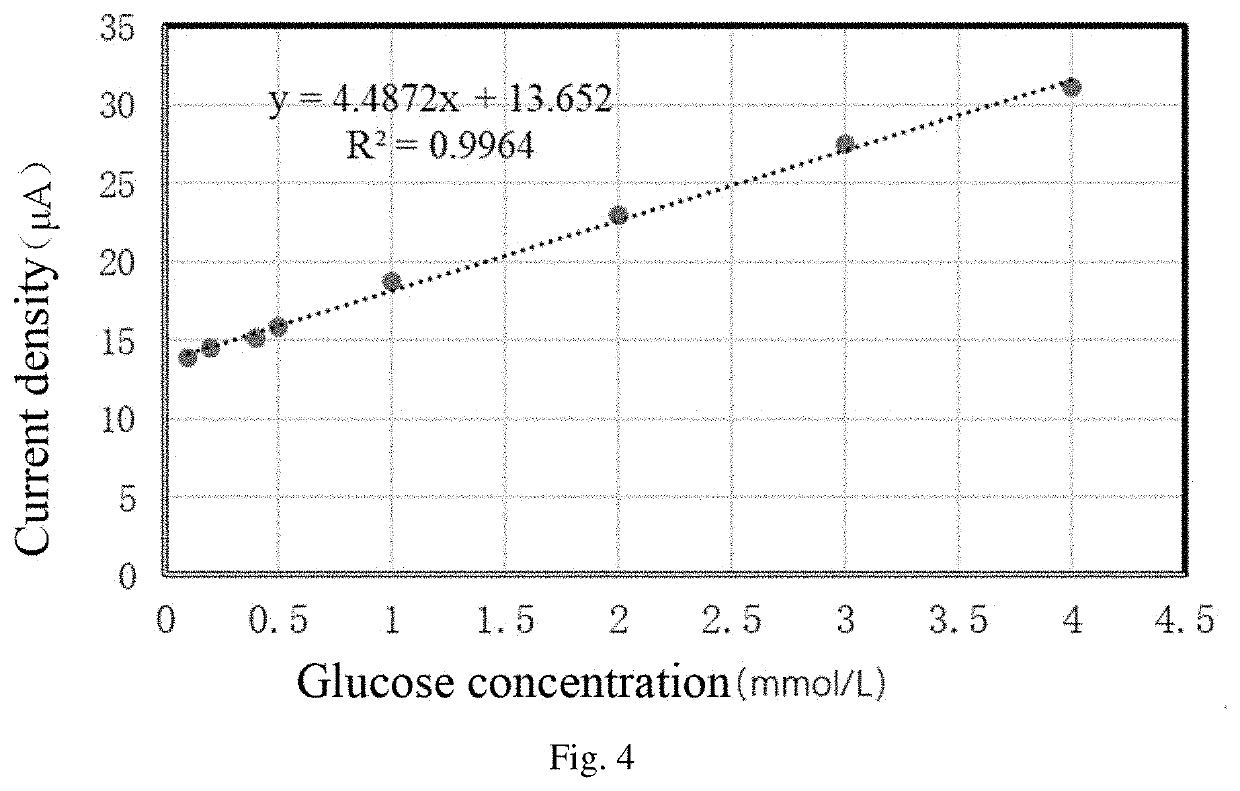Glucose Sensor Electrode, Preparation Method Therefor and Use Thereof
a glucose sensor and electrode technology, applied in the field of medical devices and instruments, can solve the problems of poor coating adhesion, high preparation cost, unstable electrode preparation process, etc., and achieve the effects of low interface resistance, strong binding force, and low cos
- Summary
- Abstract
- Description
- Claims
- Application Information
AI Technical Summary
Benefits of technology
Problems solved by technology
Method used
Image
Examples
example 1
(1) Alkali Heat Treatment of Titanium Surface
[0046]a titanium sheet (0.5 mm×10 mm×10 mm) was ultrasonically cleaned successively in acetone, ethanol and deionized water for 10 min; then a mixed acid (containing 0.54 mol / L of hydrofluoric acid and 0.25 mol / L of nitric acid) was used to clean the oxide layer on the surface of the titanium sheet for 7 min; the acid-treated material was ultrasonically cleaned in deionized water for 10 min, and then dried to obtain a pretreated titanium sheet; the pretreated titanium sheet was immersed in a hydrothermal reactor containing 70 mL of NaOH solution with a concentration of 2 mol / L, and reacted at a constant temperature of 100° C. for 24 hours; after the reaction, the titanium sheet was taken out, soaked and rinsed with deionized water, and then dried in a vacuum drying oven for use, here a nanoneedle-structured titanium dioxide layer being formed on the surface of the titanium sheet;
[0047](2) at room temperature, an infrared fiber laser print...
example 2
(1) Alkali Heat Treatment of Titanium Surface
[0052]a titanium sheet (0.5 mm×10 mm×10 mm) was ultrasonically cleaned successively in acetone, ethanol and deionized water for 10 min; then a mixed acid (containing 0.54 mol / L of hydrofluoric acid and 0.25 mol / L of nitric acid) was used to clean the oxide layer on the surface of the titanium sheet for 7 min; the acid-treated material was ultrasonically cleaned in deionized water for 10 min, and then dried to obtain a pretreated titanium sheet; the pretreated titanium sheet was immersed in a hydrothermal reactor containing 70 mL of NaOH solution with a concentration of 2 mol / L, and reacted at a constant temperature of 100° C. for 24 hours; after the reaction, the titanium sheet was taken out, soaked and rinsed with deionized water, and then dried in a vacuum drying oven for use, here a nanoneedle-structured titanium dioxide layer being formed on the surface of the titanium sheet;
[0053](2) at room temperature, an infrared fiber laser print...
example 3
(1) Alkali Heat Treatment of Titanium Surface
[0057]a titanium sheet (0.5 mm×10 mm×10 mm) was ultrasonically cleaned successively in acetone, ethanol and deionized water for 10 min; then a mixed acid (containing 0.54 mol / L of hydrofluoric acid and 0.25 mol / L of nitric acid) was used to clean the oxide layer on the surface of the titanium sheet for 7 min; the acid-treated material was ultrasonically cleaned in deionized water for 10 min, and then dried to obtain a pretreated titanium sheet; the pretreated titanium sheet was immersed in a hydrothermal reactor containing 70 mL of NaOH solution with a concentration of 2 mol / L, and reacted at a constant temperature of 100° C. for 24 hours; after the reaction, the titanium sheet was taken out, soaked and rinsed with deionized water, and then dried in a vacuum drying oven for use, here a nanoneedle-structured titanium dioxide layer being formed on the surface of the titanium sheet;
[0058](2) at room temperature, an infrared fiber laser print...
PUM
 Login to View More
Login to View More Abstract
Description
Claims
Application Information
 Login to View More
Login to View More - R&D
- Intellectual Property
- Life Sciences
- Materials
- Tech Scout
- Unparalleled Data Quality
- Higher Quality Content
- 60% Fewer Hallucinations
Browse by: Latest US Patents, China's latest patents, Technical Efficacy Thesaurus, Application Domain, Technology Topic, Popular Technical Reports.
© 2025 PatSnap. All rights reserved.Legal|Privacy policy|Modern Slavery Act Transparency Statement|Sitemap|About US| Contact US: help@patsnap.com


